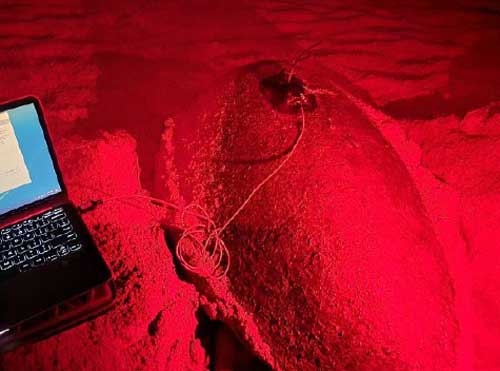Grant: 21-021R
Project Title: Establishing baseline demographics and health of a globally important loggerhead rookery: Year 2
Project Manager: Sarah Hirsch and Dr. Justin Perrault
Organization: Loggerhead Marinelife Center (Non-Profit Organization)
Grant Amount: $36,918.00
Completion Date: 2022-10-14
Summary: Clutch frequency refers to the number of nests a female sea turtle deposits within one breeding season and serves as one of the most important measures of a female's total reproductive output. Clutch frequency estimates are variable for loggerhead sea turtles (Caretta caretta) worldwide, although some of that variation is likely a result of imprecise estimates from outdated methodologies. Night-time saturation tagging programs estimate breeding parameters by encountering individual turtles nesting within a designated study site over extended periods, identifying the female with metal flipper tags and/or passive integrated transponder (PIT) tags. However, recent advancements in GPS-linked satellite telemetry have highlighted some of the pitfalls of using traditional mark-recapture studies to obtain breeding parameters. In some cases, mark-recapture methods have been attributed to overestimating populations by nearly two-fold as a result of the low nest site fidelity and re-encounter probably of sea turtles. Here, we request funds to satellite track seven loggerheads nesting in Juno Beach, Florida during the 2021 nesting season. This area is home to one of the most important loggerhead nesting grounds in the world, making accurate clutch frequency estimates critical for the long-term management of the species. In addition to clutch frequency estimates, turtles will be tracked back to their foraging grounds which can be used as a ground-truth for stable isotope samples collected from each of the females. Results: Ten nesting loggerhead turtles were outfitted with Wildlife Computers SPLASH tag satellite transmitters in April 2021. These turtles were all tagged within the first two weeks of loggerhead nesting on the east coast of Florida to ensure each female was tagged on her first nesting event of the season. A goniometer was used to successfully re-encounter females on subsequent nesting events, with a high success rate. Of the 10 turtles tagged, we re-encountered eight of them ranging from one to nine encounters (nests and false crawls). We were able to obtain serial samples from six of the turtles, two of which were able to be sampled on six of their seven nests laid. One female tagged had physical characteristics of both a loggerhead and a hawksbill. Genetic testing confirmed that she was a 50% loggerhead x 50% hawksbill hybrid. Despite being a hybrid, her size and behaviors obtained from the satellite tracking data were within the ranges of the other loggerheads. Tracks from 17 loggerheads, including 10 from this grant and 7 from grant #20-016R, were used in Sarah Hirschís Master Thesis Defense presented in the Spring of 2022 at Florida Atlantic University.
Results: Ten nesting loggerhead turtles were outfitted with Wildlife Computers SPLASH tag satellite transmitters in April 2021. These turtles were all tagged within the first two weeks of loggerhead nesting on the east coast of Florida to ensure each female was tagged on her first nesting event of the season. A goniometer was used to successfully re-encounter females on subsequent nesting events, with a high success rate. Of the 10 turtles tagged, we re-encountered eight of them ranging from one to nine encounters (nests and false crawls). We were able to obtain serial samples from six of the turtles, two of which were able to be sampled on six of their seven nests laid. One female tagged had physical characteristics of both a loggerhead and a hawksbill. Genetic testing confirmed that she was a 50% loggerhead x 50% hawksbill hybrid. Despite being a hybrid, her size and behaviors obtained from the satellite tracking data were within the ranges of the other loggerheads. Tracks from 17 loggerheads, including 10 from this grant and 7 from grant #20-016R, were used in Sarah Hirschís Master Thesis Defense presented in the Spring of 2022 at Florida Atlantic University.